In this Long Sailing Passage Preparation Checklist, you’ll find action items for safety and medical, communications, passage plans, provisioning, crew briefing/watch schedules/duties, and last-minute preparations.
What is a long sailing passage? If you’re going in the open ocean and won’t be close to land I consider that a long passage even if it’s a few days. Have a read over the list and let me know if I’m missing anything?
Long Sailing Passage Preparation Checklist
Safety & Medical
- Ensure that all the daily/weekly/monthly/quarterly routine preventative maintenance and servicing have been completed. Examples include: exercise stopcocks/thru-hull fittings (monthly), engine(s) servicing (every 200 hours), freshwater filter changes (When needed), grease stern gland/rudder/propeller (varies), grease steering lines (check monthly), etc. See Checklists For Sailors for information on all our checklists.
- Get a professional rigging check if not done within the last year or two. If a professional rig check has been done, do your own rig check. Go up the mast, check that everything is secure – check all rig fittings, cables, and connections. Check all deck connections and look at chainplates (above and below!). If anything looks suspicious, have it professionally examined. Examine the running rigging – any chafing, change the line!
- All safety equipment (Life jackets, flares, firefighting, MOB, etc.)
- Review the safety equipment location list and check that all equipment is indeed where it should be (See our Safety Equipment Location & Servicing Record in our Britican Sea Safety Manual).
- Check that all serviceable equipment is within service dates – if not, get serviced.
- Look for wear and tear and replace anything needing replacing.
- Give all crew members a tour of the safety equipment locations. Explain how the equipment is used and any associated procedures such as firefighting, Man Overboard, engine loss, loss of steering, taking on water, etc.
- Require all crew to review our Britican Sea Safety Manual to acquaint themselves with the equipment, procedures, thru-hull map, and our policies on life jacket wearing, hydration, night watches, and so forth.
More Safety & Medical
- Install jack lines down the length of the deck.
- Examine the safety lines making sure all fittings are secure and taped.
- Assign lifejackets to crew and ask them to fit the jacket to their body – each life jacket has a unique number, and each crew member keeps the same numbered jacket throughout the journey. Make sure that all life jackets have safety lines/tethers.
- Tape one safety knife to the boom vang and put the other in the cockpit table for easy access.
- Ensure that the First Aid kit is easy to get to and up to date.
- Pull out our medical equipment and medicine bags so they are readily available.
- Provide a review to all crew on the VHF procedures for making a ship-to-ship call in addition to making MAYDAY, Securite, and Pan-Pan broadcasts. Have all crew read and review the emergency broadcast checklist and templates on how to make emergency broadcasts. (Our VHF Radio Checklists and Templates are located within our Britican Sea Safety Manual).
- Check that all navigation lights are working. Make sure to have spares.
- Test automatic and manual bilge that they are, indeed, working.
- Prepare grab bag and water
- Inspect contents of grab bag making sure everything is serviced and in date.
- Put EPIRB and handheld VHF inside the bag.
- Using the waterproof bag within the grab bag, put all crew passports, wallets, and ships documents.
- Fill up water jerrycans and lash to the deck near the life raft.
Communications
- Set up the satellite communication system – Iridium Go. Activate number, ensure necessary apps are downloaded onto crew phones, test all functionality before leaving.
- Establish a relationship with a professional weather router, if using one. Discuss passage plan, desired conditions, and communication frequency.
- Lodge your passage plan with the Coast Guard and/or a few family members or friends. Determine a check-in system and ensure family/friends have details on how to follow the tracker. Test all communications before leaving port!
- Teach crew how to use communications system.

Passage Plan
- Start watching weather weeks before departure.
- Determine best weather window and route.
- Plot route on iPads, Plotter 1 and Plotter 2.
- Ensure there are numerous alternative ports to divert to if necessary.
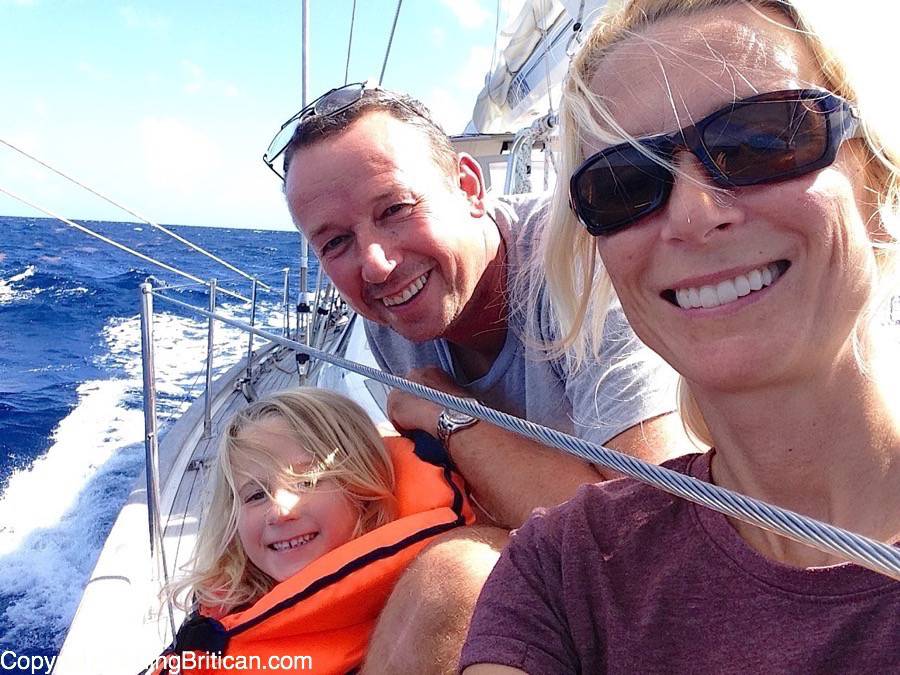
Simon, Sienna, and Me crossing the Atlantic Ocean
Provisioning
- Fill the boat with enough bottled water to last if the watermaker fails. Remember that when a bottle is finished, fill it with watermaker water and store it so we always have the same amount of bottled water on the boat.
- Make enough meal kits or full meals to store/freeze for the number of nights expected to sail. A warm hearty meal for dinner is a necessity! Create a list of meals/meal kits, location, and any extra instructions necessary to make the final meal. Display list in the galley. Ex. Chili con carne – Freezer, bottom left. Defrost overnight, heat on the stove until warm. Serve with microwave rice (in pasta cupboard) and shredded cheese (fridge, top shelf). An example of a meal kit might be Fajitas. You cut the peppers, onions, and raw chicken and throw them into a Ziplock bag with the spices. Write the instructions on the bag and freeze. When you go to make the fajitas you simply defrost, fry up, and serve with wraps, salsa, and sour cream.
- Create a list of options for lunches and provision accordingly. Make a list of items and locations. Ex. Tuna, mayo, sweetcorn wraps – Tuna and sweetcorn under starboard forward saloon cushion, mayo in the fridge, wraps in forward galley cupboard.
- For breakfast, each crew member will serve him or herself. On the grocery list, ensure to purchase a variety of easy options – oatmeal/cream of wheat packets, cereal, yogurt, fruit, breakfast cakes/bars, bagels, and toast. Time and space permitting, pre-make egg sandwiches, breakfast burritos, and/or egg quiches. Again, make a list of what’s available, where it’s located, and any instructions. Ex. Breakfast burritos – freezer, front compartment. Microwave for 1.20 minutes.
- Create snack and candy bags for each week of travel. Include things like candy bars, cookies, potato chips, crackers, etc. Each new week, bring out the next bag. If you don’t do this all the snacks will be gone too quickly!
- Purchase easy-to-make/eat items like pot noodles, soup, canned stew/chili, dried ready meals, dried fruit, nuts, and fresh fruit. If the weather/sea state is unkind, it’s often a matter of grabbing the easiest thing possible.
- For any food items that didn’t go into meals or meal kits, reduce the packaging to a minimum. Take fruit and veg out of the packaging, cereal out of boxes, remove wrappers on can goods (make sure to label cans with a sharpie of what’s in them!).
- Create a tentative meal plan ensuring that any meals requiring fresh ingredients are eaten earlier in the trip rather than later.
- Stock more than enough toilet paper, paper towels, and easy-to-use cleaning wipes. Put wipes in the heads and cockpit. Have a paper towel in the galley and cockpit.
- Special note to whoever is following this checklist! Make sure to buy yourself something nice that you can hide and eat if your spirits get tired. I purchased six Snickers bars before we crossed the Atlantic and from time to time I’d hide in our berth and eat one. It was a magical moment each time.
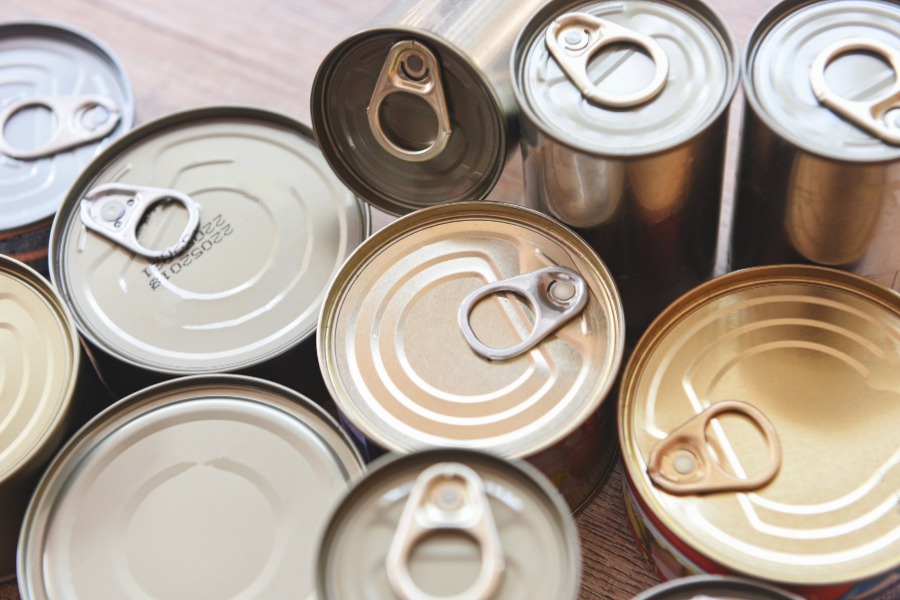
Crew Briefing, Watch Schedule & Duties
- Provide crew with a boat tour, safety equipment and procedures, and an explanation as to how to operate the boat. Go out for a test sail if possible.
- All crew to be involved with weather watching and passage planning. Review the plan daily and discuss what’s good/what’s not good.
- Create a night watch schedule having two crew in the cockpit at any given time.
- Create a rotational schedule of duties including vacuuming, cleaning the heads, making coffee, breakfast dishes, lunch prep and clean up, dinner prep and clean up, cockpit clean (sweep floor/wash table, remove any unnecessary items), saloon clean up, and fresh food monitor.
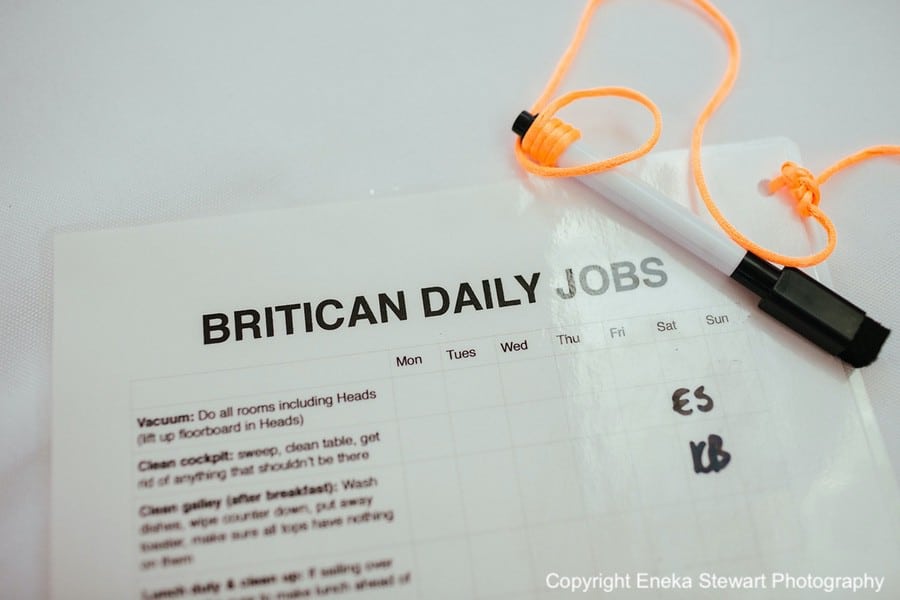
On our daily jobs list there’s lunch and dinner duty listed
Last-Minute Preparations
- Fill up with fuel and water.
- Take the outboard off the dinghy and attach it to the side of the boat. Raise dinghy on davits and secure with sail ties.
- Prepare sails and running rigging that will be used. Take the mainsail bag off and stow, set up staysail rigging (if using), and put the sail on the deck (if using).
- Set up lay clothes.
- Ensure the boat is clean, tidy, and everything is stowed away.
- Have the next couple of meals ready to grab. Ex. If lunch is the next meal, have sandwiches already made, in a bag, ready to pull out of the fridge. If it’s dinner, have the meal ready to put in the oven for heating. Create a bowl of snacks to put in the cockpit – crackers, nuts, cookies.
- Put anti-slip mats on countertops.
- Prepare logbook and pencil for use. Make sure to note departure time and set a routine schedule for entries.
- Ensure everyone has been assigned a water bottle and it’s filled daily!
- Put binoculars in the cockpit.
- Ensure that lifejackets, sun cream, hats, long sleeve shirts, and/or heavy-weather gear is easily accessible.
- Put puke bags in the cockpit.
- Pre-departure engine checks.
- Check the weather and confirm the passage plan one last time!
- Book out of the country.
- Notify friends/families that you have, indeed, left port while you still have a bit more time on your cellular data.
- Sit back and enjoy one of the most freeing, rewarding, and magical experiences you can imagine.
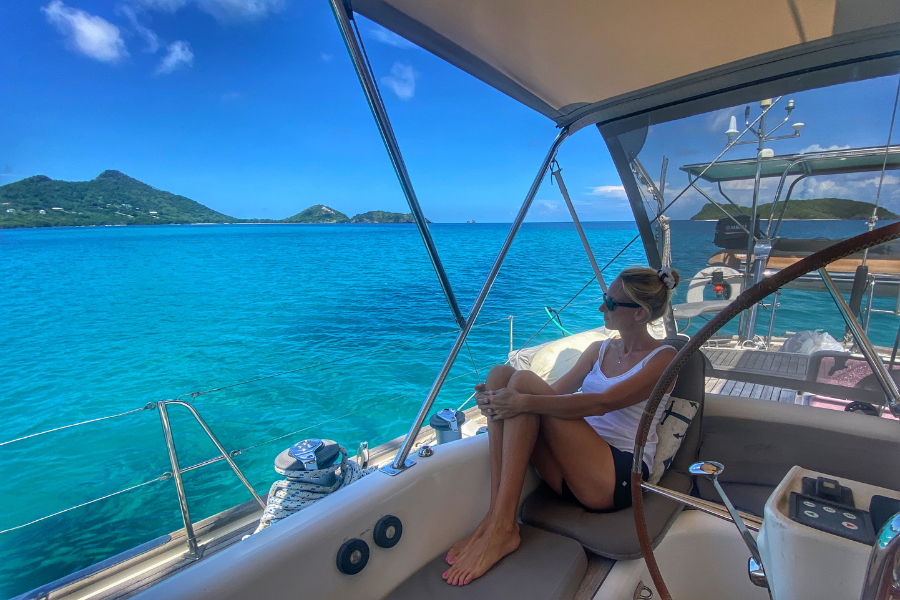
Make Sure Your SAFE Before Heading Out To Sea!
Watch our Boat Safety Blueprint Video and get a copy of our Boat Safety Audit checklist. Request access here: Boat Safety Blueprint & Audit
Long Sailing Passage Preparation Checklist Feedback?
What’s missing? Any questions? Leave them below.
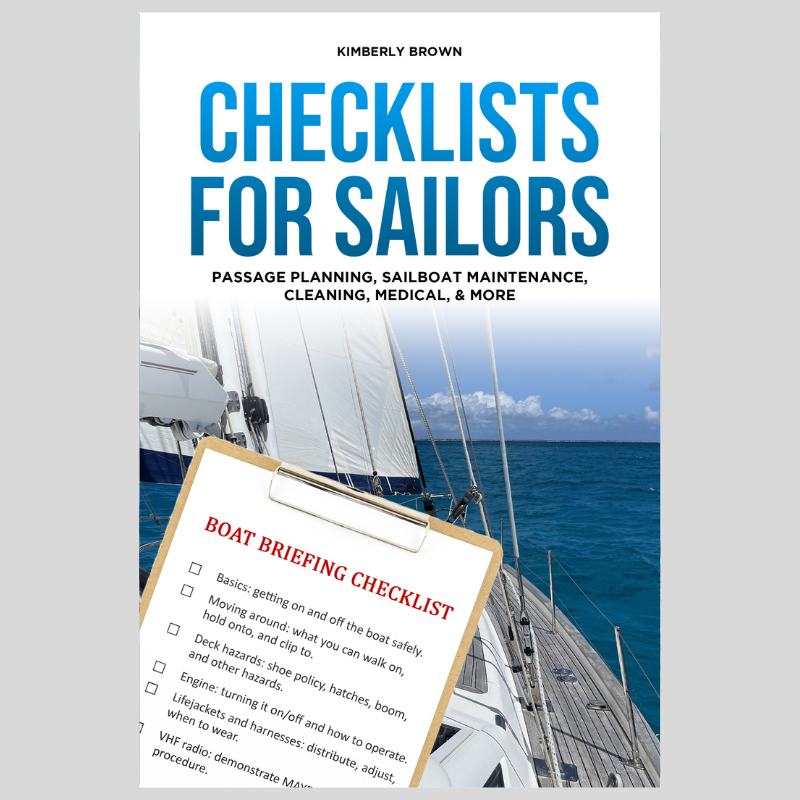
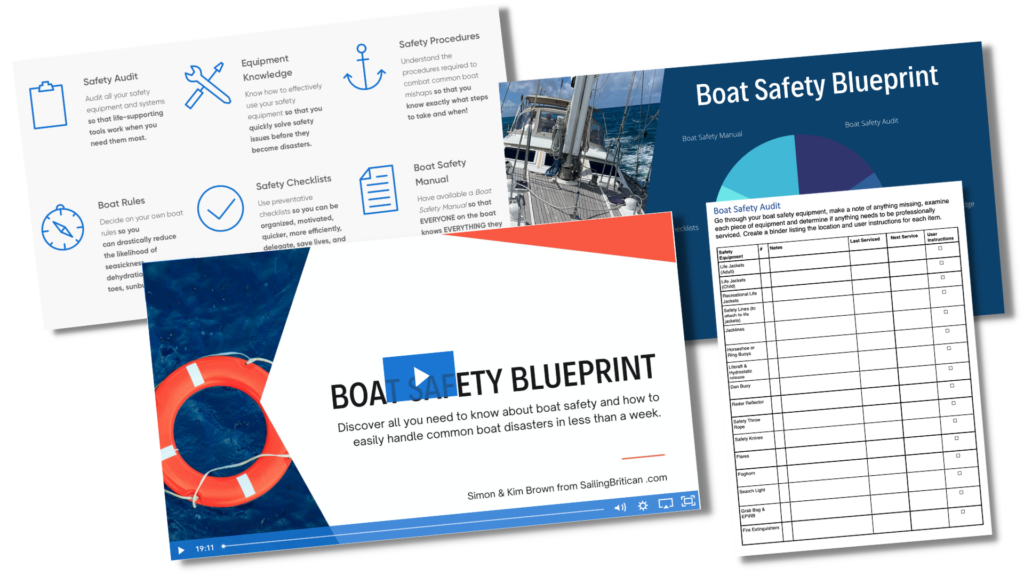
We bought packets of bread mix. Fresh bread everyday. Mix it up after breakfast, leave it to prove, pop it in the oven before lunch, a real morale boost. Also a Kindle in a Ziplock bag was a lifesaver on night watch.
Great additions Richard. Thank you! Kim
What a great modern checklist.
The hardest part of a passage has been the dull drums and long periods of sea sickness (especially with passengers – family, friends, kids, grand kids). During the pre-departure briefing I remind ‘the crew’ we may encounter these things. As the two captains try to be good hosts but sometimes guests need to be able to entertain themselves. We have an entire cupboard devoted to both these events.
Kids are the hardest to pacify… especially when they are addicted to electronics. …
and the electricity shuts down.
“Oh my god, how did that happen? I’ll get the electricity back up and running as soon as a get a chance.” I put a hidden AC outlet cutoff switch near the helm. These days, ‘landlubbers’ find cell phones and laptops are more important than being on a 50 foot luxury catamaran. Amazing how much more fun a passage is with passengers when the computers and cellphones are turned off.
During dull drums the temptation to turn the electric plugs back on is there. Board games and conversation usually get us through these moments.
The other passage downer is unfriendly weather and seas which cause sea sickness … even on a catamaran, people will carry their buckets with them. How do you deal with the dull drums and long periods of sea sickness during a passage?
Hey Calvin – great comments. We have two games we rely on when it gets boring. We play Rummikub and Mexican Train Dominoes. Even on a mono we can play these games on our cockpit table with the antislip mats. Since they are tiles they can’t fly away. Fishing takes up quite a bit of time too…and there’s excitement for a good hour or two while reeling it in, filleting it, having sushi first, and then making meals. We also do contests – so who can guess how many miles we do in 24 hours. We do that every day and at the end of the passage, someone is closest. Halfway to our destination, we have a celebration party where everyone distributes something special that they brought – perhaps some smoked sausage, candy, or something unique. We make up other odd competitions too. One time I took out some arts and craft supplies, put them on the table, and everyone had all day to make a hat. At the end of the day, we presented our hats. In our experience, our crew has loved the fact that they couldn’t be connected to electronics. Thanks again for contributing. Kim